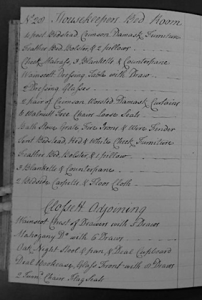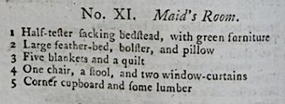Furniture for servants in the English country house, c.1700–1850
We know a great deal about the material possessions of country house owners, which form the focus of academic enquiry and the centrepiece of the visitor’s experience. In contrast, the furnishing of servants’ rooms has received scant attention, at least away from the kitchens and their related service rooms. Visitors barely get a glimpse of servants’ bedrooms, which are often hidden away in the attics, used for storage or converted into offices.
This project is attempting to address this lacuna by building a database of the provision of furniture for servants in the 18th and early 19th century. It draws information from inventories and sale catalogues for a wide range of gentry and aristocratic houses, mostly in the English Midlands.
I am interested in location of the rooms, but more especially the furniture they contained: its quantity, purpose, quality and material characteristics, including the wood and fabrics used and any ‘design’ features mentioned.
My analysis to date has focused on how provision varies according to status, role within the house, and gender. There are obvious differences between housekeepers and chamber maids, and between stewards and footmen; but equally telling are the more subtle distinctions marked in the rooms of valets, butters, ladies’ maids and chaplains.
Two particularly striking findings are the overall increase in the comfort afforded to all servants, not least in the provision of feather beds and fires, and the extent to which the rooms of senior servants in particular were furnished with items removed there from other parts of the house. This included walnut wood chairs, mahogany bed frames, and damask drapery -things that we would normally associate with luxury and taste.
My initial intention was to link this archival analysis with extant collections and rooms. Covid19 has disrupted these plans, but I hope to be able to mount pop-up exhibitions in a small number of properties in 2022. And I am keen to make contact with related projects elsewhere in Europe in order to set my findings in a broader context.
Professor Jon Stobart, Manchester Metropolitan University

